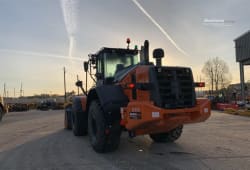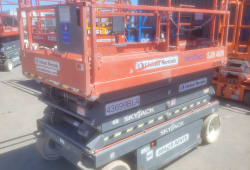Are Equipment Rebuilds an Answer to Supply Chain Challenges?
8 Min read
)
December 17, 2022
Given today's supply chain challenges, many believe equipment rebuilds are the answer. But what if they aren't? This year's Association of Equipment Management Professionals (AEMP) EquipmentSHIFT Conference 2022 was focused on this and more issues around heavy machinery. So before you commit, consider these factors and rebuild processes first to find out whether equipment rebuilds will meet your business needs and objectives better than purchasing new equipment altogether.
As a heavy machinery marketplace committed to sound client advice and proud members of AEMP, we attended this conference. Here's what we have that can help in your decision-making.
Understanding Equipment Rebuilds
In most cases, a part of an item that gets worn down or broken can be rebuilt and used again. This can work with any type of machine but is mostly practical, economical, and time-efficient with heavy machinery. The cost of this process depends on how much damage was done and how many parts are needed.
To understand how equipment rebuilds may be able to help your business, you first need to know what an equipment or machine rebuild is.
What Is a Machine Rebuild?
A machine rebuild or refurbishment is the entire process involved in the disassembly, replacement, and reassembly of machine components to restore the machine to its original condition. It can be done on either an existing machine or one that has been scrapped. The process may either involve stripping down and refreshment or rebuilding the machine's individual components, replacing OEM parts and then reassembling it, or rebuilding a complete frame-up rebuild before finally testing it to make sure everything works as intended.
The Machine Rebuild Process
Different heavy machinery manufacturers, such as John Deere, Komatsu, and Caterpillar, carry out machine rebuilds in an almost similar fashion. When looking at a rebuild from a manufacturer's perspective, they do it to ensure the machines are safe and efficient for use for a projected timeframe before wear. Though the process might differ from one manufacturer to the next, here is what's involved in most equipment rebuilds:
The first step is a critical technical inspection of the machine. This involves accurate oil sample history, an inspection of critical components like hoses and belts and the hydraulic system, and an evaluation of fuel burn, idle time, corrosion, wear, and use. Safety and work equipment are also inspected during this stage.
What follows next is a full review of the machine's history. All service records, log books, and diagnostic information are reviewed during this phase. If there have been repairs or replacement of major parts over the lifetime of the machine, then those should be noted too.
The next step is a detailed and documented inspection by a technician before the rebuild process. During this stage, technicians also verify the availability of the needed parts, and the client decides the level of refurbishment desired. Once everything is at par, the client is issued with a detailed quote.
Next, the machine arrives at the rebuilding site, where a post-demolition inspection is done. During the rebuild process, technicians document any additional repairs and update the quote accordingly. After completion, the machine is prepared for delivery to the client with a review and final invoice.
Here are rebuild programs from major manufacturers:
John Deere Powertrain ReLife Plus Program
One of the more common questions we hear from our customers is: What do I do with my old machines? The most obvious answer is to replace them, but what if it's not in your budget? With John Deere's Powertrain ReLife Plus Program, many of these machines can be brought back to life.
This program involves a thorough and detailed machine inspection before the complete replacement or rebuild of the powertrain. Customers also have the option of choosing a customized rebuild plan that's specifically tailored to their needs. They also get to enjoy extended powertrain component warranty and financing options.
Komatsu Joy Rebuild Program
This program aims to reduce the turnaround time and create value by giving clients new-like equipment at a fraction of the cost of a new one. It also includes incorporating critical engineering updates and features necessary for operator comfort, safety, productivity, and efficiency. Komatsu delivers flexible rebuild services that meet the client's requirements by offering customer-centric custom solutions that other manufacturers can emulate. This program provides custom equipment rebuilds and technology retrofits at rates that match the client's needs. Additionally, Komatsu protects the client's investment after a rebuild by offering 10,000 hours of component assurance, financing, and a reassessment partnership.
Cat® Certified Rebuild Program
The Certified Rebuild Program comes packed with complete and component rebuild options for commercial engines, powertrains, hydraulic systems, machine components, and more. They include:
Complete Machine Rebuild (CMR)
This all-around rebuild involves over 200 tests and inspections to ensure the machine comes out looking and feeling new. It involves a complete frame-up rebuild with the intention of replacing everything that needs replacing. Additionally, there's also a new suite of offerings that include a new serial number and the option to get a remote identification number which can allow their customers to write machines off as CapEx expenses.
Powertrain Rebuild
Everything that encompasses the powertrain, from the engine, radiator, transmission, and other powertrain components, is replaced or rebuilt to bring that like-new effect. A subsidiary of this is the Powertrain Plus Rebuild; it involves rebuilding anything beyond the powertrain, such as general repairs to any components of your equipment or tech updates.
Complete Powertrain Plus Hydraulic Rebuild
This takes care of the refurbishment of the powertrain and the hydraulic system, with the option to add some optional rebuild requests. It's the package that most clients go for. Other program packages include Machine Component Rebuilds, which offer an array of optional component rebuilds from engines, torque converters, axles, differentials, and final drive. Hydraulic Rebuilds are great for hydraulic excavators, while Commercial Engine Rebuilds take care of industrial gas engines, generators, pumps, and locomotives.
Customers also have the advantage of integrated service offerings such as an extended protection plan, financing, and a new warranty.
The Pros of Equipment Rebuilds
Equipment rebuilds are a viable option for individuals or companies looking to mitigate supply chain challenges. They may offer an attractive solution because they provide a less expensive alternative when compared with purchasing new equipment.
Another significant benefit of equipment rebuilds is that they may help add value and prolong your current equipment's life, saving you money in the long run. On the other hand, some argue that a more cost-effective strategy is to purchase used equipment on the secondary market instead of paying for an equipment rebuild.
Are Rebuilds the Solution to the Equipment Replacement Dilemma and Supply Chain Issues?
Companies are always striving to find new ways to improve their supply chains. One possible solution gaining traction in recent years is equipment rebuilds. And while it may seem like equipment rebuilds are the answer to your supply chain challenges, the truth is that they're not always that simple to solve.
Finding the right balance of equipment and service can be challenging when it comes to the supply chain. On the one hand, you want to get the most value possible out of your equipment by taking the time to find high-quality rebuilds that are guaranteed to last, but on the other hand, you don't want to delay production with long lead times when it comes time to make necessary repairs or upgrade your machinery.
Finding a balance between these two options can be difficult, especially without expert knowledge. As such, many companies are turning to experienced supply chain consultants or opting to purchase certified used equipment from trusted marketplaces like Boom & Bucket. However, the truth is that there isn't really any easy solution to your supply chain challenges - it takes a lot of research, planning, and understanding of your available options to build an effective plan.
Buy a Certified Used Equipment
When faced with significant equipment failures at the wrong time of your production cycle, the best solution may be to buy certified used equipment to help maintain supply. However, the decision to buy a certified used machine or rebuild will depend on a number of factors, including available capital and margins. Before making a final decision, consider the cost of downtime and whether you can afford a quality rebuild.
With this in mind, buying certified used machinery may be worth it if your goal is to keep up with demand without sacrificing profit margin. To get your hands on any certified used equipment, visit our website for the best deals.
Summarizing using table for Equipment Rebuild Programs Comparison
:format(webp)) Equipment rebuild programs offer comprehensive solutions for extending the lifespan of heavy machinery. Each program provides unique benefits tailored to specific client needs, ensuring cost-effectiveness and operational efficiency.
Equipment rebuild programs offer comprehensive solutions for extending the lifespan of heavy machinery. Each program provides unique benefits tailored to specific client needs, ensuring cost-effectiveness and operational efficiency.














